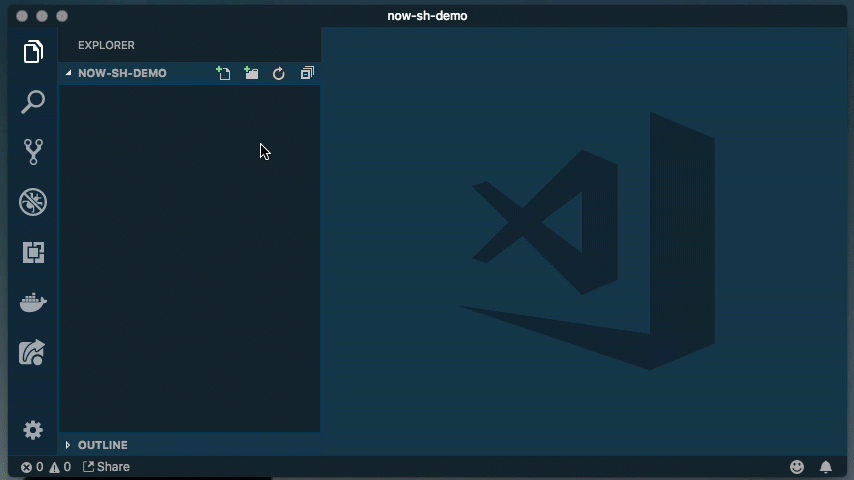I recently fell in love with now.sh. It's a super nice hosting service which let's deploy static websites, node powered websites or Docker containers using i single command in your terminal: now. You literally write now in your terminal and your site is live in seconds:

The original video clip was less than 1:45 minutes!
My biggest interest in now was their Docker support. That meant I would be able to run ASP.NET Core applications easily and, most importantly, cheaply.
I started out very hopeful and happy. I had a Dockerfile which had a build step and a final container only containing the final, compiled bits. I packaged the compiled bits in the official ASP.NET Core Docker image:
FROM microsoft/dotnet:2.1-sdk AS build
WORKDIR /source
COPY . .
RUN dotnet restore
RUN dotnet publish -c Release -o /output
FROM microsoft/dotnet:2.1-aspnetcore-runtime
EXPOSE 80
WORKDIR /app
COPY --from=build /output .
CMD ["dotnet", "NowShDemo.dll"]
But this made me hit an unforeseen obstacle. The size of the final Docker image can't be larger than 100 megabytes. Ouch!

Luckily, now.sh does some "compression" (the Assembling image step) on their end, meaning that the Docker image they're looking at is actually a bit smaller, than the "raw" image produced when building from the Dockerfile locally. They report the image to be 116.7 megabytes, while it's 258 megabytes on my disk.
The code is just the content of the default ASP.NET Core MVC template and I'm already over the size limit. What to do?
The first trick is to use a smaller Linux base image. By scrolling down a bit on the microsoft/dotnet page in the official Docker registry, you'll find there are runtime (and SDK) images based on Alpine. Alpine is known for it's fantastically small image size and is popular to use with Docker. Alpine's image is 4 megabytes! That's the whole operating system!
I change my final Docker image to use the Alpine variant:
FROM microsoft/dotnet:2.1-sdk AS build
WORKDIR /source
COPY . .
RUN dotnet restore
RUN dotnet publish -c Release -o /output
FROM microsoft/dotnet:2.1-aspnetcore-runtime-alpine
EXPOSE 80
WORKDIR /app
COPY --from=build /output .
CMD ["dotnet", "NowShDemo.dll"]
This changed the image size on my disk to 167 megabytes. That's 91 megabytes shaved off. When I deploy this image to now.sh, it's deployed without problem. now.sh reports the size of the image to be 76.8 megabytes, which is well below the limit.
Happy times!
But. Can I do better though? Could I manage to make the image even smaller? I bet I can!
As of version 2.1 of .NET Core, Alpine is a fully supported runtime target. That means you'll be able to compile your application to a self-contained deployment, which gives you a native executable for Alpine, your code and the .NET Core runtime.
By adding <RuntimeIdentifier>alpine-x64</RuntimeIdentifier> right below the TargetFramework tag in my csproj file, I'm able to compile my code to run on 64-bit Alpine. I also need to specify that I'm building for alpine when I'm running dotnet publish.
.NET Core needs some tools and/or applications to be installed on Alpine to be able to run properly. You could set up the image to install these dependencies, but thankfully, Microsoft provides a Docker image with the dependencies installed. This Docker image is used when building the Alpine runtime image I used earlier.
My Dockerfile now looks like this:
FROM microsoft/dotnet:2.1-sdk AS build
WORKDIR /source
COPY . .
RUN dotnet restore
RUN dotnet publish -c Release -o /output -r alpine-x64
FROM microsoft/dotnet:2.1-runtime-deps-alpine
EXPOSE 80
WORKDIR /app
COPY --from=build /output .
CMD ["./NowShDemo"]
You'll also notice that the CMD command at the bottom is changed to calling an executable file in the current directory, instead of going through dotnet.
This new image is 115 megabytes on my disk. Another 52 megabytes saved! now.sh reports it's size as 51.5 megabytes. This is good!
Can I take it even farther? Sure I can!
When you create a ASP.NET Core MVC project from the default template it includes a package called Microsoft.AspNetCore.All. This is a so-called metapackage which only contains references to other packages. In this case, those other packages are all the packages that make up ASP.NET Core.
If I remove that all encompassing package and add only the bits I use, I might be able to shave off a few extra megabytes.
After some trial and error I'm able to change my csproj from this:
<ItemGroup>
<PackageReference Include="Microsoft.AspNetCore.App"/>
</ItemGroup>
To this:
<ItemGroup>
<PackageReference Include="Microsoft.AspNetCore" Version="2.1.3" />
<PackageReference Include="Microsoft.AspNetCore.Hosting" Version="2.1.1" />
<PackageReference Include="Microsoft.AspNetCore.HttpsPolicy" Version="2.1.1" />
<PackageReference Include="Microsoft.AspNetCore.CookiePolicy" Version="2.1.1" />
<PackageReference Include="Microsoft.AspNetCore.StaticFiles" Version="2.1.1" />
<PackageReference Include="Microsoft.AspNetCore.Mvc" Version="2.1.2" />
</ItemGroup>
Instead of pulling in all of ASP.NET Core, I'm only using the parts I explicitly need for my code to run. You could probably save even more by splitting up the Microsoft.AspNetCore.Mvc package, but I'm quite happy with this result.
The new Docker image is only 105 megabytes on disk, that's another 10 megabytes off. After deploying that image to now.sh, it reports the size to be 47.4 megabytes. A new record!
During the course of this experiment I was able to go from a Docker image of 258 megabytes to an image of 105 megabytes. That's less than half the original size, without removing any of my code! The image that is deployed to now.sh has shrunken from 116.7 megabytes to 47.4 megabytes!
Mind you, this is not a real site I'm running; it's just the code from the default ASP.NET Core MVC template. But it might give you some inspiration on how to shrink your Docker images.
Feel free to ping me on Twitter if you have any questions or comments.